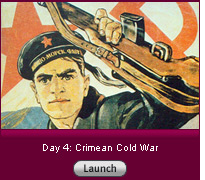Crimea Scene Investigation
But the connection between Russian politics and the Black Sea fleet is understood by everyone here. The fleet's presence in Sevastopol has become the single most contentious issue in the Russian-Ukrainian dispute over Crimea. Russian nationalist politicians have made Sevastopol's status a cause célèbre, and Mayor Luzhkov has made frequent visits to Sevastopol, giving speeches that argue it is a "Russian city" and claim that a loophole in the 1954 agreement transferring Crimea from Russia to Ukraine excepted Sevastopol. He has funded housing for Russian sailors, Russian Orthodox churches, and the establishment of a branch of Moscow State University in Sevastopol.
Finally, the Ukrainian government got fed up and declared Luzhkov persona non grata in 2008. Ukrainian President Viktor Yushchenko said the fleet will have to leave when its current lease expires in 2017. And when several ships in the Black Sea fleet were used in the South Ossetia war against Ukrainian ally Georgia, Yushchenko tightened the rules on Russian use of the port. Now Russian ships have to give 72 hours' notice before they leave the port.
Sevastopol doesn't feel as much like a living city as it does a museum to the heroic past. Entering the city, visitors are greeted with a World War II-era train-mounted artillery piece painted with the slogan "Death to Fascism." The central part of the city is full of handsome white alabaster neoclassical buildings from the czarist era—or so it appears. The city was almost completely destroyed in World War II, but Stalin spared it the fate of most ruined cities—to be rebuilt in soulless concrete—and allowed it to be reconstructed to its former glory. There are 2,000 monuments around the city, including a massive World War II memorial with an eternal flame that is guarded by high-school students in military-style uniforms, as well as monuments to the dead of the Afghanistan war and Crimean War (in which Sevastopol also played a critical and heroic role, defending Russian territory from a combined European-Turkish force). The city's Lenin statue has an uncharacteristically out-of-the-way location, while the most prominently placed statue is of Adm. Pavel Nakhimov, a Crimean War hero.
The streets are filled with Russian navy officers in dress uniforms. (You occasionally see Ukrainian sailors, too—their much smaller Black Sea fleet is also based here.) Even at a punk show I attended, several of the young men in the audience wore blue-and-white striped Russian navy shirts under their leather jackets or Sex Pistols T-shirts. And its residents are proud. The first two people I met in the city called it "the most beautiful city in the former Soviet Union" and "the most beautiful city in the world."
From a military perspective, Sevastopol isn't quite what it used to be. While the Black Sea fleet once numbered as many as 635 ships, it's now down to about 60 operational vessels on the Russian side and a half-dozen on the Ukrainian side, the rest reduced to scrap. In the days of the Soviet Union, there were 100,000 service members and military support staff based in Sevastopol; that is down to 40,000 now. The agreement between Russia and Ukraine regulating the fleet's operation stipulates that ships can only be repaired or replaced with an equivalent ship, so as the fleet ages, it is gradually becoming obsolete. The Black Sea itself is not a particularly hot spot, and passage out of the sea is tightly governed by Turkey, which controls the straits into the Mediterranean. Russia is reportedly considering moving the fleet to Novorossiysk, the largest Russian port on the Black Sea, or even to Mediterranean ports in Libya or Syria.
But if Sevastopol's real strategic importance is on the wane, its symbolic importance remains. I met Adm. Vladimir Solovyev, the former intelligence chief of the Black Sea fleet, who is now head of the local office of the Institute of Countries of the Commonwealth of Independent States, a Moscow-based think tank that promotes Russian influence in former Soviet republics. When I arrived, the front desk called to his office: "Comrade Kucera and Comrade Gladenko [my translator] are here to see you." He greeted me wearing a lapel pin featuring the flags of Russia and Abkhazia, the Russia-backed slice of Georgia that has broken free and is recognized only by Russia and Nicaragua.
Solovyev said he still sees a future for the fleet in Sevastopol. The agreement that restricts new equipment from coming in is open to interpretation, he said. "Russia doesn't take this seriously. Now it doesn't matter, because we don't have any new ships, but when we get new ships, they will try to solve this." Besides, he added, Novorossiysk isn't as good a port as Sevastopol, and Libya or Syria was unlikely. "Russia doesn't base ships abroad," he said. "Our goal is not to conquer countries, but to free them."
The important thing in dealing with Sevastopol, he said, is not strategic military interests but "the human factor." People in Sevastopol don't have a problem being part of Ukraine, as long as the Russian character of the city is acknowledged. He said when there are joint military parades featuring both Russian and Ukrainian forces, "everything is positive. But when the Ukrainian government tries to have events that show only their side, no one shows up. When Russia organizes parades, the whole harbor is full of people."
"The people here want to be with Russia," he said. "I don't know what would happen if the fleet had to leave in 2017. I think what happened in South Ossetia would look mild in comparison."
